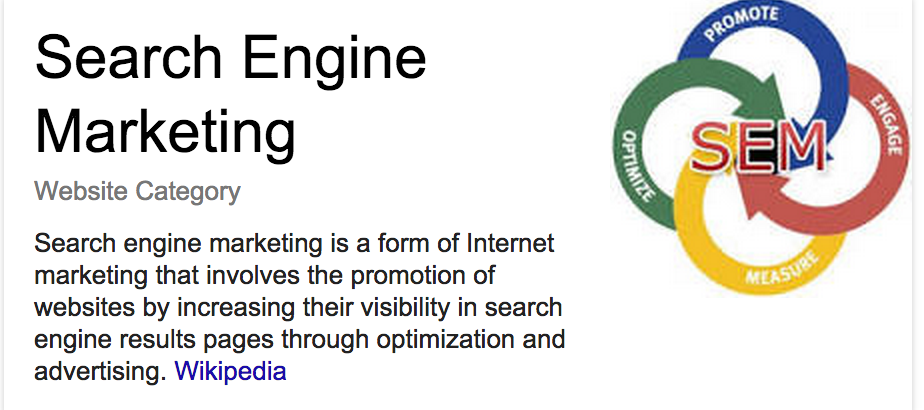If you ever find yourself wondering, “what exactly is search engine marketing”, take a step back, and think about the words themselves. It’s no misnomer. Search engine marketing is marketing on a search engine.
There. Now we’ve covered the obvious. Wasn’t that helpful? No?! Why not?
Because while none of the above is untrue, neither does it encompass the entire truth.
The term Search Engine Marketing used to refer to both organic (SEO) and paid (PPC) advertising efforts. While it’s not incorrect to use “SEM” as a term that incorporates organic (unpaid) search engine efforts, Search Engine Marketing as a concept has matured to be associated more closely with paid initiatives.
Obviously the exchange of money between advertiser and platform is the defining difference between the two methodologies, but the financial backing doesn’t tell the whole story.
Think of a search engine results page as a newspaper, or a magazine. In these venues, you have the content generated by the publisher— which is what the reader pays to receive. This is the publisher’s product.
Then you also have the advertisements, which run alongside the editorial content, but are notably separate. They are marked so that the reader intuitively understands that the paid content does not influence the editorial content.
But all this doesn’t so much answer the question of “what is SEM” so much as it provides context for the answer.
If you dig around for a definition, you’ll find something that looks like this, or at least a close variation:
Search engine marketing is a form of Internet marketing that involves the promotion of websites by increasing their visibility in search engine results pages through optimization and advertising
In fact, that’s the very definition when you type the search query “what is SEM” into Google. Meta enough for you?
However, the answer to the question of “what is search engine marketing” isn’t the type of thing that can be packaged into a one sentence definition and then tied with a neat little bow.
And so I’ll take a crack at explaining what makes search engine marketing different from conventional channels.
The truth is, to those already familiar with all of digital marketing’s moving parts, the profound difference can be explained in one word: intent. Specifically, searcher’s intent.
Search engine marketing can do something that other marketing avenues and methodologies— billboards, television spots, product placement, native advertising— cannot: serve an advertisement at the precise moment it will be relevant to the audience’s intent.
For those who do not understand the advertising-specific meaning in the concept of intent, fear not; it’s easy to grok.
Imagine for a moment that you’re back home after a grueling day at the office, feet kicked up on the ottoman, cat purring contentedly on your stomach, the rain beating against your window, and your refreshment of choice in hand. Nice, isn’t it?
Now, imagine that your favorite program breaks for commercial. Suddenly you’re inundated with advertisements for shoes. Frankly, you could use a new pair. Your sneakers are basically worn through the sole from all the tennis you’ve been playing— hey, swimsuit season’s just around the corner, and you’ve gotta keep those calves well-turned somehow.
But the last thing you’re thinking about in that moment is your shoes. In fact, you just kicked your toe-crimpers into the corner, willfully forgotten until the next morning when you’ll have to reluctantly slide your protesting feet back into their painful embrace.
Point is, this moment probably isn’t the best time to serve a shoe ad to you, even if it is relevant on some level (which is by no means guaranteed— for all that advertiser knows, you could have purchased a new pair of shoes from a competitor just the day before.)
Now, let’s fast forward to some random point in the near future. You’re lacing up the ol’ sneakers to get back on the court. The shoelace snaps in your hand, and it occurs to you, it’s probably time to remedy this woeful footwear scenario.
And so, inspired in the moment, you do what any consumer who has breathed twenty-first century air does: you go to a little website called www.google.com and type in “tennis shoes”— and so begins your search engine marketing journey.
There you are, tennis shoes on the brain, telling the world you want a new pair, when BAM!, in the very moment you’ve confessed your intent, you’re served a roster of highly pertinent ads for tennis shoes.
What’s more likely to result in a sale, and a contribution to bottom line revenue for the advertiser: an advertisement served on a whim to a mass audience, or an advertisement that will not be triggered until something explicitly denotes that it will be relevant?
That is search engine marketing: advertising with relevance that prior to the Internet, could never have been achieved.
So what did we learn today? We learned that search engine marketing is getting tennis shoes when you want tennis shoes.




